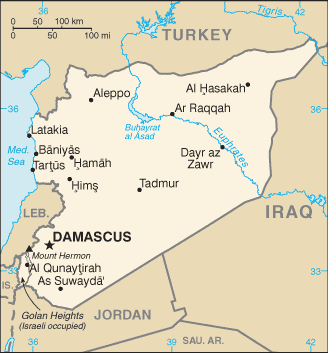Syria
Related Categories:
 Flags of the Arab World
Flags of the Arab WorldIn Arab flags there is the story of islam, of foreign incursions and domination, of struggles for independence, of the Arabs aspirations to supranational unity and of their enduring love for historic lands.
www.saudiaramcoworld.com/
Meaning of the Colours, Hanging Flag, Flag Variants, Presidential Flag.
www.fotw.us/
Archaeologists have demonstrated that the civilization in Syria was one of the most ancient on earth. Around the excavated city of Ebla in northern Syria, discovered in 1975, a great Semitic empire spread from the Red Sea north to Turkey and east to Mesopotamia from 2500 to 2400 B.C.
en.wikipedia.org/
Ethnic Syrians are of Semitic stock. Syria's population is 90% Muslim--74% Sunni, and 16% other Muslim groups, including the Alawi, Shi'a, and Druze--and 10% Christian. There also is a tiny Syrian Jewish community.
Arabic is the official, and most widely spoken, language. Arabs, including some 500,000 Palestinian and up to 1.3 million Iraqi refugees, make up 90% of the population. Many educated Syrians also speak English or French, but English is the more widely understood. The Kurds, many of whom speak the banned Kurdish language, make up 9% of the population and live mostly in the northeast corner of Syria, though sizable Kurdish communities live in most major Syrian cities as well. Armenian and Turkic are spoken among the small Armenian and Turkoman populations.
Most people live in the Euphrates River valley and along the coastal plain, a fertile strip between the coastal mountains and the desert. Overall population density is about 140 per sq. mi. Education is free and compulsory from ages 6 to 11. Schooling consists of 6 years of primary education followed by a 3-year general or vocational training period and a 3-year academic or vocational program. The second 3-year period of academic training is required for university admission. Total enrollment at post-secondary schools is over 150,000. The literacy rate of Syrians aged 15 and older is 88% for males and 74% for females.
Ancient Syria's cultural and artistic achievements and contributions are many. Archaeologists have discovered extensive writings and evidence of a brilliant culture rivaling those of Mesopotamia and Egypt in and around the ancient city of Ebla. Later Syrian scholars and artists contributed to Hellenistic and Roman thought and culture. Zeno of Sidon founded the Epicurean school; Cicero was a pupil of Antiochus of Ascalon at Athens; and the writings of Posidonius of Apamea influenced Livy and Plutarch. Syrians have contributed to Arabic literature and music and have a proud tradition of oral and written poetry. Although declining, the world-famous handicraft industry still employs thousands.
www.state.gov/r/
Introduction
About
Contact
Symbols in The News
Interpret this Symbol
AAC
African
AI
Alchemy
Alphabets
Ancient
Animal Symbolism
Architecture
Art
Articles
Astrology
Baha'i
Blissymbolics
Blueprint Symbols
Buddhist
Celtic Symbols
Cemetery
Chinese Symbols
Christian
Circle
City
Codes
Color
Conlangs
Crop Circles
Danger
Da Vinci Code
Designing Logos
Dictionaries
Dreams
Education
Egyptian Symbols
Electrical
Emoticons
Find Images
Fonts
Food
Fraternity
Hamsa
Healing
Heraldry
Hermetic
Highway Signs
Hindu
History
Hobo
Holiday
Icons
iConji
Islamic
Jain Symbols
Japanese, Kanji
Jewish
Justice
Law
Literary Symbolism
Mandalas
Map
Masonic
Math, Number
Meaning of Names
Medical
Middle East
Military
Miscellaneous
Money
Music
Mythology
Native American
Playing Cards
Power
Psychology
QiQiiKhu
Reiki
Religious
Runes, Norse
Sacred Geometry
Scientific
Science Fiction
Sorority
Sports
Symbols in the News
Tattoos
ThirteenSymbols
Tree of Life
Ursprache
Videos
Visual Languages
Weather
Web Codes
Wicca
Words
Writing Systems
Braille
Coinherence
Coptic
Cuneiform
Easter Island
Etruscan
Happy Human
Hebrew
Kokopelli
Linear B
Lotus
Love Symbols
Mandorla
Moon Alphabet
Nine Pointed Star
Om
Oz
Phonetic
Scarab Beetle
Silent
Theosophy
Unifon
About
Contact
Symbols in The News
Interpret this Symbol
AAC
African
AI
Alchemy
Alphabets
Ancient
Animal Symbolism
Architecture
Art
Articles
Astrology
Baha'i
Blissymbolics
Blueprint Symbols
Buddhist
Celtic Symbols
Cemetery
Chinese Symbols
Christian
Circle
City
Codes
Color
Conlangs
Crop Circles
Danger
Da Vinci Code
Designing Logos
Dictionaries
Dreams
Education
Egyptian Symbols
Electrical
Emoticons
Find Images
Fonts
Food
Fraternity
Hamsa
Healing
Heraldry
Hermetic
Highway Signs
Hindu
History
Hobo
Holiday
Icons
iConji
Islamic
Jain Symbols
Japanese, Kanji
Jewish
Justice
Law
Literary Symbolism
Mandalas
Map
Masonic
Math, Number
Meaning of Names
Medical
Middle East
Military
Miscellaneous
Money
Music
Mythology
Native American
Playing Cards
Power
Psychology
QiQiiKhu
Reiki
Religious
Runes, Norse
Sacred Geometry
Scientific
Science Fiction
Sorority
Sports
Symbols in the News
Tattoos
ThirteenSymbols
Tree of Life
Ursprache
Videos
Visual Languages
Weather
Web Codes
Wicca
Words
Writing Systems
Braille
Coinherence
Coptic
Cuneiform
Easter Island
Etruscan
Happy Human
Hebrew
Kokopelli
Linear B
Lotus
Love Symbols
Mandorla
Moon Alphabet
Nine Pointed Star
Om
Oz
Phonetic
Scarab Beetle
Silent
Theosophy
Unifon

